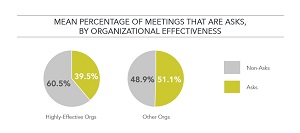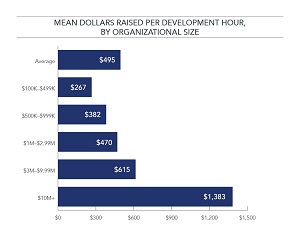 Special to the Philanthropy Journal
Special to the Philanthropy Journal
By Jeremy Beer
If you run a nonprofit organization or manage a nonprofit’s development department, you know that finding relevant performance benchmarks is difficult. Most of the fundraising reports offer simply average numbers across all nonprofits as if there are no meaningful differences between a multimillion-dollar public university and a local homeless shelter. In the for-profit world, everyone knows that a million-dollar services company is vastly different from a billion-dollar manufacturer. No one thinks that a metric that is good for one is therefore good for the other. Isn’t the same true for nonprofits?
 At best, surveys of nonprofits’ fundraising will break down their findings by sector, but usually in ways so broad as to not be very helpful: healthcare, education, and so forth. What is needed is (1) data broken down by organizational size, and (2) findings that apply to organizations operating in a sphere similar enough to make averages meaningful and extrapolation possible.
At best, surveys of nonprofits’ fundraising will break down their findings by sector, but usually in ways so broad as to not be very helpful: healthcare, education, and so forth. What is needed is (1) data broken down by organizational size, and (2) findings that apply to organizations operating in a sphere similar enough to make averages meaningful and extrapolation possible.
At American Philanthropic, we are frequently asked by our clients to assess their development operations. Two basic questions naturally arise: How does my nonprofit measure up compared to similar organizations? And: What should my organization do to imitate the highest-performing organizations in our area?
Many of our clients operate in the faith-based, center-right, or liberty-oriented spaces (one thing that unites them is that they typically receive zero government funds). After floundering around for a few years, we eventually came to realize we needed data from that world, broken down by organizational size, so that our clients could get an accurate idea of how they stack up. We also realized that we needed to differentiate highly effective organizations from other groups.1
So last year we surveyed 99 faith-based, center-right, and libertarian-leaning groups with 35 questions directly related to development, including personnel, boards, direct mail, foundation solicitations, donor cultivation, corporate gifts, event revenue, online fundraising, and planned giving.
- Investing in development pays off. For every hour of organizational time invested in fundraising, even small organizations raised at least $250. The overall average was $500—which we estimate to be about 10 times the cost of the average development hour.
- Direct mail is vitally important. Groups of all sizes reported that they received an extremely high return on their investment in house-file solicitations, and the most highly effective organizations invested heavily in direct-mail prospecting even though their collective return-on-cost was average at best. They seemed to understand better than others that investing in donor acquisition pays off in the long run.

- Foundation grants account for a surprisingly large percentage of survey participants’ development revenue. We didn’t expect this, but overall, grants accounted for 41% of groups’ development revenue, and the percentage was higher the larger the group. This percentage is considerably higher than the national average for nonprofits, pegged by the latest Giving USA Report at 16%. Here we see how the particular sphere in which one operates makes a huge difference.
 There is an underinvestment in planned giving and online giving. Few survey participants reported receiving planned gifts, despite the high average size of such gifts, and their collective percentage of revenue derived from online sources was lower than reported national averages.
There is an underinvestment in planned giving and online giving. Few survey participants reported receiving planned gifts, despite the high average size of such gifts, and their collective percentage of revenue derived from online sources was lower than reported national averages.- Relationship-building is crucial. The survey showed larger organizations conducted many more one-on-one donor meetings per development staffer than their peers. Importantly, a far lower proportion of high-performing groups’ meetings were asks, indicating that these groups understand the importance of investing in relationship-building—and don’t treat their donors like ATMs.
 The most highly effective organizations are not necessarily the most efficient. This was counterintuitive but a pretty clear finding: the best-performing organizations didn’t separate themselves by, for example, raising more money per development staff member or getting better returns in the mail. Instead, they seemed to invest in fundamental development activities whatever the immediate results, knowing that the work will pay off in the end.
The most highly effective organizations are not necessarily the most efficient. This was counterintuitive but a pretty clear finding: the best-performing organizations didn’t separate themselves by, for example, raising more money per development staff member or getting better returns in the mail. Instead, they seemed to invest in fundamental development activities whatever the immediate results, knowing that the work will pay off in the end.
It’s probable that our findings apply to many secular, center-left, and progressive groups, as well as groups with no ideological profile at all—especially those which do not receive much if any government funding. But at the very least, we now have relevant benchmarks that faith-based and center-right groups can use to compare their performance to others. And we have data indicating how the very best performers distinguish themselves.
We summarize our findings in terms of a general philosophy: the three factors most important for nonprofit success are patience, a commitment to fundraising fundamentals, and a focus on relationship-building. To make things even simpler, our mantra has become: Mail, Meetings, Foundations. If you are in charge of a nonprofit’s fundraising efforts, you could do worse than to adopt it as your own.
1To qualify as highly effective, organizations had to be either “highly admired” or “fast growing.” Highly admired organizations were those that were mentioned as admired at least two times by survey participants. Fast-growing organizations were those whose revenue had grown by 100% or more since 2009 or 66% or more since 2011, excluding organizations with a current revenue of less than $550,000.
Jeremy Beer is a founding partner at American Philanthropic, a firm that provides professional consulting and development services to nonprofit organizations. Reach him at jbeer@americanphilanthropic.com.
The Fundraising Performance Report can be found at http://www.americanphilanthropic.com/publications/fundraising-performance-report/.





